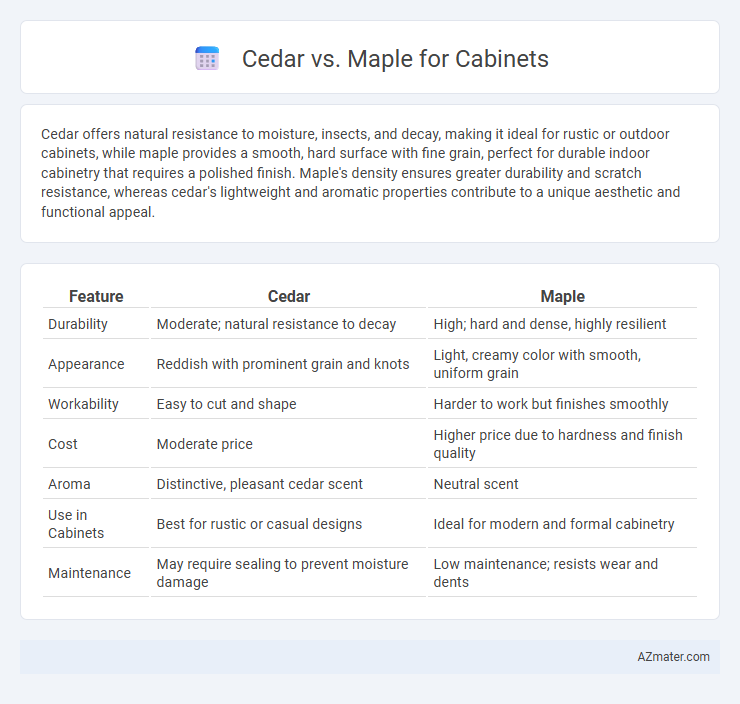Cedar offers natural resistance to moisture, insects, and decay, making it ideal for rustic or outdoor cabinets, while maple provides a smooth, hard surface with fine grain, perfect for durable indoor cabinetry that requires a polished finish. Maple's density ensures greater durability and scratch resistance, whereas cedar's lightweight and aromatic properties contribute to a unique aesthetic and functional appeal.
Table of Comparison
| Feature | Cedar | Maple |
|---|---|---|
| Durability | Moderate; natural resistance to decay | High; hard and dense, highly resilient |
| Appearance | Reddish with prominent grain and knots | Light, creamy color with smooth, uniform grain |
| Workability | Easy to cut and shape | Harder to work but finishes smoothly |
| Cost | Moderate price | Higher price due to hardness and finish quality |
| Aroma | Distinctive, pleasant cedar scent | Neutral scent |
| Use in Cabinets | Best for rustic or casual designs | Ideal for modern and formal cabinetry |
| Maintenance | May require sealing to prevent moisture damage | Low maintenance; resists wear and dents |
Introduction to Cedar and Maple Cabinets
Cedar cabinets offer natural resistance to moisture and insects, making them ideal for environments prone to humidity and pests. Maple cabinets are prized for their smooth, fine grain and durability, providing a sleek, modern aesthetic that resists dents and scratches. Both wood types deliver unique benefits, with cedar emphasizing natural protection and warmth, while maple offers strength and an elegant finish suitable for high-traffic kitchen areas.
Key Differences Between Cedar and Maple Wood
Cedar wood is known for its natural resistance to moisture, insects, and decay, making it ideal for cabinets in humid or outdoor environments, while maple wood offers exceptional hardness and durability, providing better resistance to dents and scratches. Cedar features a distinct aromatic scent and a reddish hue with prominent grain patterns, whereas maple presents a lighter, uniform color with a fine, smooth grain, contributing to a clean and modern cabinet appearance. The cost of cedar is generally lower and easier to work with due to its softness, whereas maple's density requires more effort to shape but results in a longer-lasting, high-end finish for cabinetry.
Appearance and Grain Patterns
Cedar cabinets showcase a reddish-brown hue with rich, straight grain patterns that provide a rustic, warm aesthetic ideal for traditional or cabin-style interiors. Maple features a lighter, creamy color with subtle, uniform grain patterns that create a smooth, clean look suitable for modern and contemporary designs. Both woods offer distinct visual appeals, with cedar emphasizing bold texture and warmth, while maple delivers a sleek and refined appearance.
Durability and Strength Comparison
Cedar cabinets offer moderate durability with natural resistance to moisture and insects, making them suitable for humid environments but less resistant to heavy impacts compared to maple. Maple is renowned for its exceptional strength and hardness, providing superior resistance to dents, scratches, and wear, which makes it ideal for high-traffic and heavy-use cabinetry. The dense grain structure of maple ensures long-lasting performance, while cedar's softer texture may require more careful handling to maintain its appearance and structural integrity.
Resistance to Moisture and Pests
Cedar offers superior resistance to moisture and pests compared to maple, making it ideal for areas prone to humidity and insect exposure. Its natural oils provide a protective barrier against rot and termite damage, while maple is more susceptible to swelling and insect attacks if not properly sealed. For long-lasting cabinetry in damp or pest-prone environments, cedar delivers enhanced durability and protection.
Cost and Affordability
Cedar cabinets typically have a higher price point due to their natural resistance to moisture and insects, making them a durable but costlier choice. Maple cabinets offer a more affordable option with excellent hardness and smooth grain, ideal for budget-conscious homeowners seeking quality and longevity. Comparing cost per board foot, maple generally ranges from $7 to $12, while cedar costs $10 to $15, influencing overall cabinet affordability and value.
Maintenance and Care Requirements
Cedar cabinets require regular sealing or finishing to prevent moisture damage and maintain their aromatic properties, while also benefiting from occasional dusting to preserve their natural oils. Maple cabinets are known for their dense hardwood, demanding less frequent sealing but still needing gentle cleaning with mild soap and water to prevent surface staining and maintain their smooth finish. Both wood types benefit from controlling humidity levels and avoiding harsh chemicals to extend their lifespan and keep the cabinet surfaces looking pristine.
Best Applications for Cedar Cabinets
Cedar cabinets excel in applications requiring natural resistance to moisture, insects, and decay, making them ideal for kitchens and bathrooms where humidity levels are higher. Their aromatic properties help repel pests and add a distinctive scent that enhances storage for linens and clothing in closets. Cedar's softness allows for easy customization and detailed carvings, suitable for rustic or cabin-style interiors seeking warmth and durability.
Ideal Uses for Maple Cabinets
Maple cabinets are ideal for kitchens and bathrooms due to their durability and smooth grain, which supports a variety of finishes and paints. Unlike cedar, which is often chosen for its aromatic properties and natural resistance to insects, maple provides a harder surface that resists dents and scratches, making it perfect for high-traffic areas. The neutral tone of maple wood complements both modern and traditional designs, enhancing the visual appeal and functionality of cabinetry.
Which Wood is Better for Your Cabinets?
Maple offers a smoother, more uniform grain and greater durability, making it ideal for high-traffic kitchen cabinets that require frequent cleaning and resistance to dents. Cedar provides natural resistance to moisture and insects, with a distinct aroma and rustic appearance, best suited for cabinetry in less-demanding environments or specialty spaces like pantries. Choosing between cedar and maple depends on the desired aesthetic, durability requirements, and environmental conditions of your cabinetry project.

Infographic: Cedar vs Maple for Cabinet
 azmater.com
azmater.com